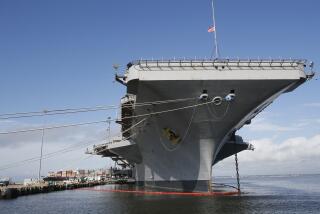GAO Report Takes Aim at Navy’s Fleet Dispersal Plan
- Share via
WASHINGTON — The General Accounting Office, in a draft report not yet released, expresses strong reservations about Navy plans to disperse its growing fleet among more than a dozen additional home ports, and says that other options--including concentrating ships in California--could prove less costly.
The draft, obtained Friday from Capitol Hill sources, discussed a number of other options that it found “considerably less costly.” Among them are basing the entire West Coast fleet, now slated to be distributed among several ports, in Long Beach and moving the aircraft carrier Nimitz and its escort groups to San Diego or San Francisco. The Navy now plans to move the Nimitz from its present Norfolk, Va., port to Everett, Wash.
Determining where the ships will be berthed is one of the most politically sensitive aspects of the Administration’s plan to expand the Navy’s present fleet by 120 ships, to 600. Construction or expansion of a port means a huge boost for a local economy.
Moreover, spreading the wealth to more lawmakers’ districts and constituents helps broaden congressional support for expansion of the fleet at a time when Congress is considering dramatically scaling back the Administration’s military buildup.
Navy Secretary John F. Lehman Jr. also repeated, in testimony Friday before the Senate Appropriations defense subcommittee, the Administration’s contention that dispersal of the ships among numerous ports makes strategic sense.
“We want to disperse to build a broader mobilization base,” Lehman said. He said that the Soviet fleet now deployed off U.S. shores has “the ability to mine and to fire conventional cruise missiles that give an element of vulnerability to triple-berthed, closely packed ports (heavily concentrated in Norfolk, San Diego and Charleston, S.C.) that was not there several years ago.
“The Soviet Union now operates their submarines right off our coast in the Gulf of Alaska and we have no forces that deploy up in the region routinely to deal with them. We have to deploy them all the way up from the San Diego area.”
In its draft report, the GAO called upon the Navy to “better demonstrate the strategic benefits of new home ports and to prepare more definitive and complete cost estimates as a basis for proceeding further.”
The report by the GAO, Congress’ auditing arm, was requested by Sen. Strom Thurmond (R-S.C.), whose Senate armed services subcommittee on military construction plans to hold hearings on the issue soon.
In response to requests from The Times, the Navy declined to comment on the draft report until it is released publicly.
However, an aide to Sen. Pete Wilson (R-Calif.) said Navy officials have complained privately that the GAO did a poor job of computing the costs of the alternatives. For example, the aide said, the Navy said the report did not include costs that would be incurred in dredging and adding housing to the ports that would be expanded under the alternatives studied.
More to Read
Get the L.A. Times Politics newsletter
Deeply reported insights into legislation, politics and policy from Sacramento, Washington and beyond. In your inbox twice per week.
You may occasionally receive promotional content from the Los Angeles Times.










